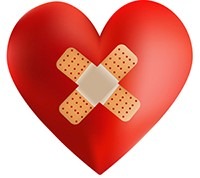Life, as we know, is often hanging by a thread. How many times we have gotten surprised for unexpected news when a loved one in full health, is suddenly lacking. That thread that binds us to life can be broken in a moment. Interrupting and affecting us emotionally and disrupting plans, like a switch turns off the light.
 Robert (fictitious name), fifty years old, his career as a manager, with high corporate responsibilities and a busy life made of meetings, reports, frequent moves, lies in his office awaiting to go to the airport for yet another business trip.
Robert (fictitious name), fifty years old, his career as a manager, with high corporate responsibilities and a busy life made of meetings, reports, frequent moves, lies in his office awaiting to go to the airport for yet another business trip.
Its 2:00 pm when a strange chest pain, never felt before, makes him change his mind, and is accompanied to the clinic where I currently work.
The diagnosis is acute myocardial infarction and at 3.00 pm the cardiologists are involved in the cath lab for an angioplasty on the right coronary artery complicated by bradycardia, which requires the introduction of wires for electrical stimulation with a temporary pacemaker.
To controls performed after the procedure, everything seems fine, and the patient was sent to the intensive coronary care unit.
After half an hour, Robert is sick, vital signs deteriorate. Echocardiographic examination shows the presence of a large pericardial effusion that leads us to diagnose justifiably of perforation of the heart.
The cardiologists bring Robert in the cath lab for the evacuation of pericardial effusion by percutaneous drainage and alert myself, heart surgeon afternoon shift. We made arrangements for the operating room for a possible emergency.
The result of percutaneous drainage seems positive because all the liquid (blood) present in the pericardial cavity is drained. At the end of the procedure the patient is monitored with serial echocardiographic examinations and continuous monitoring of vital parameters that remain stationary. In the vast majority of cases, drilling, if small, if it involves the right ventricle, closes by itself. They decide the removal of temporary pacing electrodes that could be among the causes of the breach in the ventricle.
At 5.00 pm Robert is transferred to the Intensive Care Unit. After a few moments stay in this department there is a sudden deterioration of the patient’s vital signs that lead up to cardiac arrest. By means of cardiac massage, cardiovascular activity is restored sufficiently to transfer Robert in the operating room for emergency.
In a few minutes we open the patient’s chest. At the opening of the pericardium the blood comes out, under high pressure, making its way through the breach of the right ventricle compressing the heart to make it stop from cardiac tamponade. The breach is as big as a hazelnut, probably caused by infarction and favored by the introduction of electro stimulation wires needed at that time.
The opening of the pericardium closes the vicious circle that in such cases this leads to death if the patient does not have the option of surgery in emergency.
Once we identified the breach, everything becomes easier, just a stitch to successfully resolve a condition sadly irreversible.
Controlling the cardiovascular risk factors, should be a must. Smoking, diabetes, high blood pressure, high cholesterol and stress, are the main enemies of our hearts. Let us commit ourselves to fight them and bring them back into the threshold of normality with serious controls and appropriate treatments.
 The story of Robert, unfortunately, is common. A young person in full working activity that is in good health, he finds himself in a few hours, suddenly, struggling between life and death.
The story of Robert, unfortunately, is common. A young person in full working activity that is in good health, he finds himself in a few hours, suddenly, struggling between life and death.
Investigating his medical history, we find two of the five mentioned risk factors. Please do not consider it just a coincidence!
The heart attack is the leading cause of death in industrialized countries.
20-30% of patients with myocardial infarction died shortly after onset of symptoms before being seen by a doctor (pre-hospital mortality). The mortality of patients with myocardial infarction who arrive and treated in the department of coronary care unit is 5-8%. If we consider the overall mortality for heart attack, between causes, 20% of deaths have undergone a rupture of the ventricular wall.
Robert is now at home, leading a regular life and promised to keep under strict surveillance his risk factors.
Do not let a stitch be the arbiter of our lives. A stitch that can decide between life and death of a person.
A phone call … extends the life reminds us a well-known Italian TV spot.
With a smile, I would add that, at times, even a stitch … extends the life!

